todo perfecto. Un 10
Ver traduzidoAntigo Egito, Pré-dinástico Faience Escaravelho com o nome do faraó Tutmés III. Novo Reino, 18ª Dinastia, 1479 - 1425 a.C. 1,9 cm
N.º 90000343
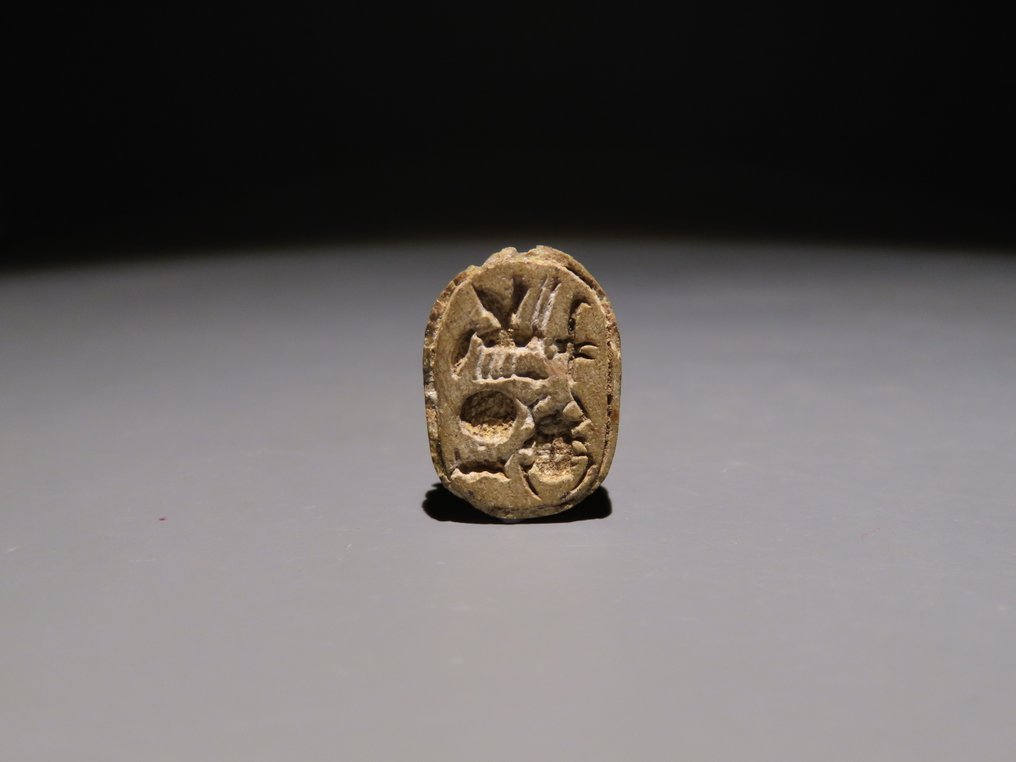
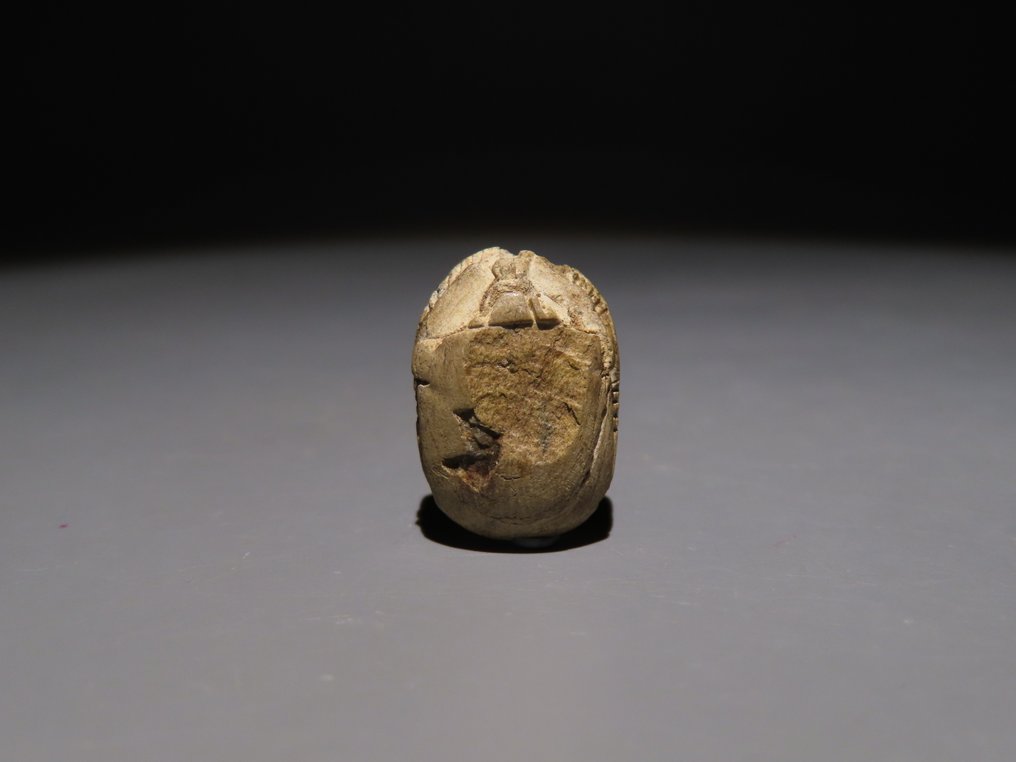
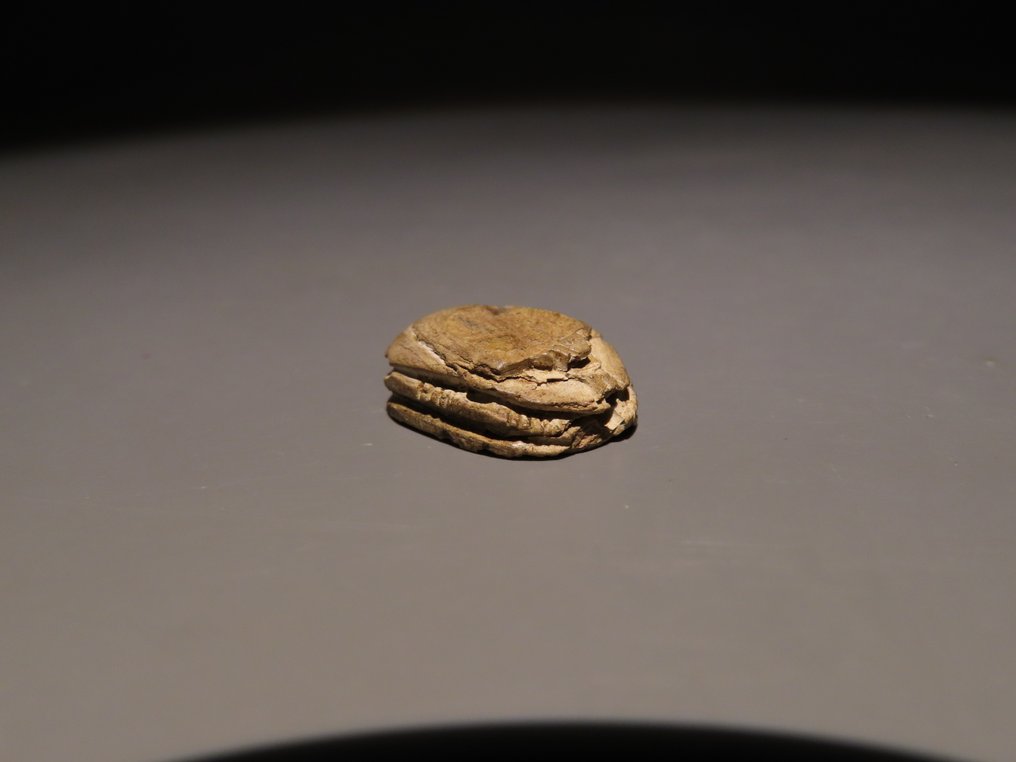
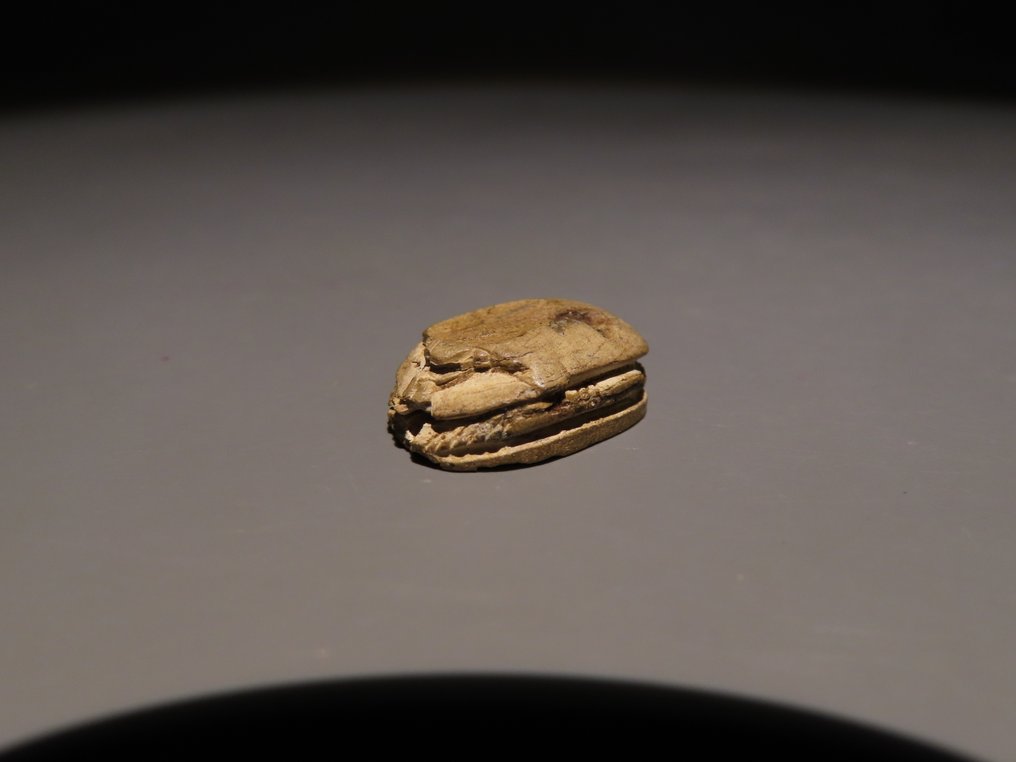
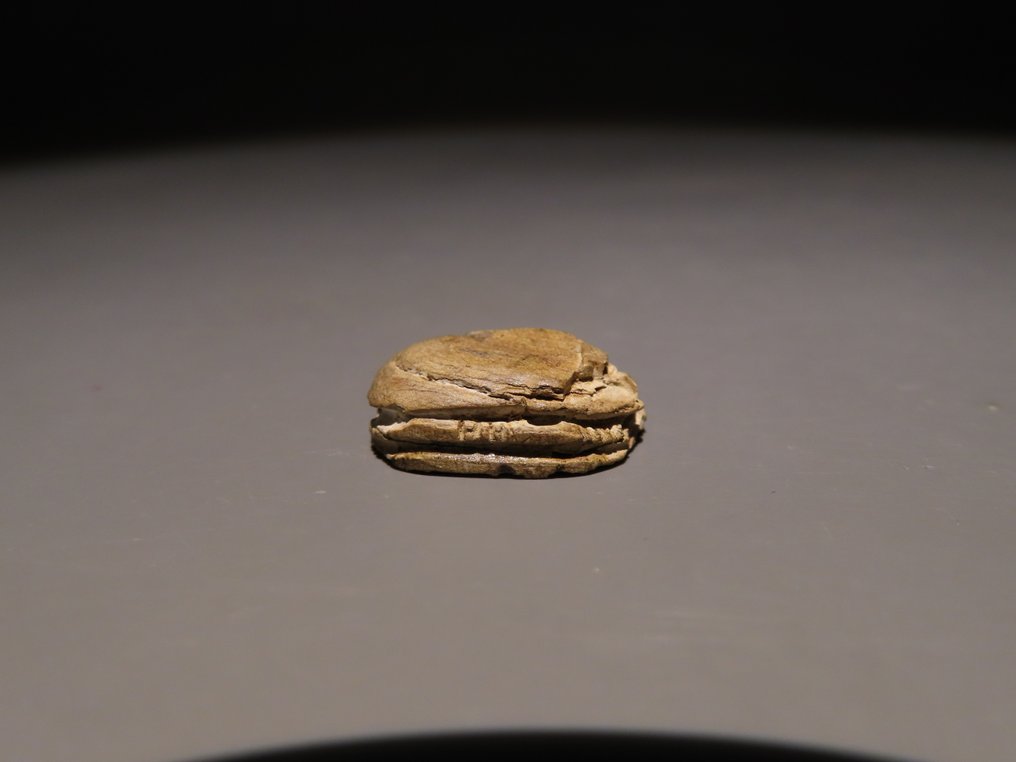
Scarab with the name of Pharaoh Thutmose III.
Ancient Egypt, New Kingdom, 18th Dynasty, Reign of Pharaoh Thutmose 3rd, 1479 - 1425 BC.
Faience.
1.9 cm length.
Condition: Good condition.
Provenance: Private collection Donald Wonder (1938 - 2023), California, United States of America.
Acquired at various auction houses between 1994 - 1993 between:
- Harmer Rooke Galleries, New York, Mail Bil Auction XVIII, March 30, 1984, Lot 114.
- Time Machine Co., Queens, New York, Auction #3, March 25, 1993, Lot 259 and 266.
Description:
The heart scarab is an oval, scarab artifact dating from ancient Egypt. Mostly an amulet, it was also used as jewelry, a memorializing artifact, or a grave good. The heart scarab was used by referring to Chapter 30 from the Book of the Dead and the weighing of the heart, being balanced by Maat, goddess of truth, justice, order, wisdom, and cosmic balance. The function of the heart scarab was to bind the heart to silence while it was being weighed in the underworld to ensure that the heart did not bear false witness against the deceased. As in many current religions, the individual had to show 'worthiness' to achieve the afterlife. The heart was extremely important to ancient Egyptians as the seat of intelligence and the storehouse of memory. It was the only organ left in place during mummification. Heart scarab amulets were meant as substitutes for the heart should the deceased be deprived of the organ in the afterlife. For example, when a person died, a heart scarab was often placed on their heart and bound underneath the bandages of the mummy. This was to ensure that it could not be physically removed from their person.
The significance of the heart scarab to the ancient Egyptians also stems from the religious importance of the scarab beetle, Scarabaeus sacer. The scarab beetle represented rebirth and creation. As the beetle larvae grow, they eat their way out of the balls of dung where they were laid and emerge. The Egyptians saw this as the beetles emerging from nothingness into new life, which aligns with their beliefs in an afterlife and rebirth.
The amulets are described in the Book of the Dead to be made (per Andrews, Amulets of Ancient Egypt) of a stone: nmhf, nemehef (not now identified); typically green stones, green jasper, serpentine, and basalt. Andrews continues to say they are in fact made from: green or dark-green materials, such as glazed steatite, schist, feldspar, hematite and obsidian; also blue-glazed composition (faience), Egyptian blue, rock crystal, alabaster or red jasper. Instead of the head of a scarab, heart scarabs had the head of a human and were often inscribed with chapter 30B of the Book of Going Forth by Day. Heart scarabs were also used in the design of pectorals, which were a rectangular chest ornament.
The alternate heart amulet itself represents similar ideas, but is made in the form of the heart as used by the Egyptian language hieroglyph.
Notes:
The piece includes authenticity certificate.
The piece includes Spanish Export License.
Mais sobre o vendedor
Scarab with the name of Pharaoh Thutmose III.
Ancient Egypt, New Kingdom, 18th Dynasty, Reign of Pharaoh Thutmose 3rd, 1479 - 1425 BC.
Faience.
1.9 cm length.
Condition: Good condition.
Provenance: Private collection Donald Wonder (1938 - 2023), California, United States of America.
Acquired at various auction houses between 1994 - 1993 between:
- Harmer Rooke Galleries, New York, Mail Bil Auction XVIII, March 30, 1984, Lot 114.
- Time Machine Co., Queens, New York, Auction #3, March 25, 1993, Lot 259 and 266.
Description:
The heart scarab is an oval, scarab artifact dating from ancient Egypt. Mostly an amulet, it was also used as jewelry, a memorializing artifact, or a grave good. The heart scarab was used by referring to Chapter 30 from the Book of the Dead and the weighing of the heart, being balanced by Maat, goddess of truth, justice, order, wisdom, and cosmic balance. The function of the heart scarab was to bind the heart to silence while it was being weighed in the underworld to ensure that the heart did not bear false witness against the deceased. As in many current religions, the individual had to show 'worthiness' to achieve the afterlife. The heart was extremely important to ancient Egyptians as the seat of intelligence and the storehouse of memory. It was the only organ left in place during mummification. Heart scarab amulets were meant as substitutes for the heart should the deceased be deprived of the organ in the afterlife. For example, when a person died, a heart scarab was often placed on their heart and bound underneath the bandages of the mummy. This was to ensure that it could not be physically removed from their person.
The significance of the heart scarab to the ancient Egyptians also stems from the religious importance of the scarab beetle, Scarabaeus sacer. The scarab beetle represented rebirth and creation. As the beetle larvae grow, they eat their way out of the balls of dung where they were laid and emerge. The Egyptians saw this as the beetles emerging from nothingness into new life, which aligns with their beliefs in an afterlife and rebirth.
The amulets are described in the Book of the Dead to be made (per Andrews, Amulets of Ancient Egypt) of a stone: nmhf, nemehef (not now identified); typically green stones, green jasper, serpentine, and basalt. Andrews continues to say they are in fact made from: green or dark-green materials, such as glazed steatite, schist, feldspar, hematite and obsidian; also blue-glazed composition (faience), Egyptian blue, rock crystal, alabaster or red jasper. Instead of the head of a scarab, heart scarabs had the head of a human and were often inscribed with chapter 30B of the Book of Going Forth by Day. Heart scarabs were also used in the design of pectorals, which were a rectangular chest ornament.
The alternate heart amulet itself represents similar ideas, but is made in the form of the heart as used by the Egyptian language hieroglyph.
Notes:
The piece includes authenticity certificate.
The piece includes Spanish Export License.
Mais sobre o vendedor
- 780
- 8
- 3
Punctual and maximum professionalism as usual. Very satisfied.
Ver traduzidoOttimo venditore, tutto perfetto, velocissimo anche nella spedizione
Ver traduzidoTutto perfetto velocità anche nella spedizione
Ver traduzidoMuy correcto Muy rápido
Ver traduzidoItem as described, documentation attached and very fast delivery. Everything perfect! Thank you.
Ver traduzidoAll excellent, many thanks!
Ver traduzidoOggetto meraviglioso!imballato con cura e spedito davvero rapidamente,venditore top tutto perfetto!
Ver traduzido👍🏻very fast delivery. Great item. Thank you
Ver traduzidoEnvoi super rapide, merci ! Et objet parfaitement conforme à sa description 😊
Ver traduzidoGreat item! Great seller!!
Ver traduzidoBel objet, très bien emballé, très bien livré !
Ver traduzidoBel objet, très bien emballé, très bien livré !
Ver traduzidoBel objet, très bien emballé, très bien livré !
Ver traduzidoSuperbe objet, très bien emballé, très bien livré !
Ver traduzidoBel objet, très bien emballé, très bien livré ! Parfait !
Ver traduzidoFeines Stück! Schneller Versand und netter Kontakt.Gerne wieder!
Ver traduzidoThank you very much. Surprisingly it has arrived in one piece. Greetings!
Ver traduzidoMooi object , snel en goed verzonden. Ziet er prima uit.
Ver traduzidosoooo good!
Ver traduzidoWie immer alles bestens! Vielen Dank
Ver traduzidoWhat an amazing, authentic piece of history to have! Will be treatened with respect, honor and love. Thank you so much everything is fine and truly special to hold.
Ver traduzidoInmejorable vendedor. Todo perfecto. Muchas gracias.
Ver traduzidoObjet parfaitement conforme à la description, livraison sécurisée et très rapide !
Ver traduzidoOggetto molto bello e risulta ancor piu' affascinante a vederlo di presenza. Imballo perfetto, spedizione veloce e sicura.
Ver traduzidoAviso Legal
O vendedor garante e pode provar que o objeto foi obtido legalmente. O vendedor foi informado pela Catawiki que tinha de fornecer a documentação exigida pelas leis e regulamentos do seu país de residência. O vendedor garante que tem o direito de vender/exportar este objeto. O vendedor fornecerá ao comprador toda a informação conhecida sobre a proveniência do objeto. O vendedor garante que serão ou já foram obtidas todas as autorizações necessárias. O vendedor informará imediatamente o comprador de quaisquer atrasos na obtenção de tais autorizações.
O vendedor garante e pode provar que o objeto foi obtido legalmente. O vendedor foi informado pela Catawiki que tinha de fornecer a documentação exigida pelas leis e regulamentos do seu país de residência. O vendedor garante que tem o direito de vender/exportar este objeto. O vendedor fornecerá ao comprador toda a informação conhecida sobre a proveniência do objeto. O vendedor garante que serão ou já foram obtidas todas as autorizações necessárias. O vendedor informará imediatamente o comprador de quaisquer atrasos na obtenção de tais autorizações.